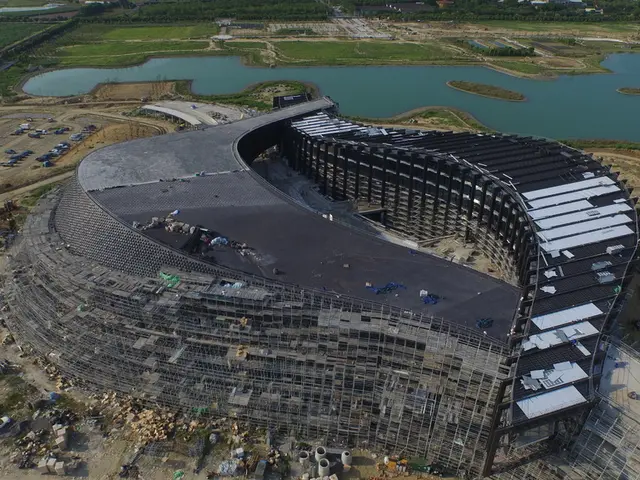Expanding Hydrogen Fuel Cell Market Anticipates Robust 23.52% Expansion
The hydrogen fuel cell market is experiencing a surge in growth, driven by a global focus on sustainability and governmental support for clean energy solutions. According to recent projections, the market was valued at approximately USD 5.10 billion in 2024 and is expected to grow at a compound annual growth rate (CAGR) of around 23.5%, reaching USD 42.17 billion by 2034 [1]. Another source anticipates a CAGR of about 26.3% from 2025 to 2030, with the market reaching around USD 18.16 billion by 2030 [2].
One of the key trends shaping the market is the expansion of fuel cell vehicles (FCVs). With their zero-emission profile, FCVs are gaining popularity due to government initiatives worldwide aimed at reducing carbon emissions, particularly in regions like the Asia-Pacific (currently the largest market) and Europe (the fastest-growing due to aggressive carbon-neutral targets) [1].
Proton Exchange Membrane Fuel Cells (PEMFCs) remain the dominant technology in the market, thanks to their mechanical strength and flexibility, which make them ideal for automotive applications [1][3].
The logistics sector is driving demand for hydrogen fuel cell commercial vehicles due to their efficiency for transporting goods and people over long distances [1]. Innovations and new product launches are also playing a significant role in market growth, with companies like Toyota releasing third-generation fuel cell systems in 2025 [1].
Regional developments are also contributing to the market's growth. North America, for example, is a significant market with strong R&D investment and infrastructure development supported by federal and state initiatives like the Inflation Reduction Act [2]. India recently deployed its first hydrogen-powered truck to replace diesel vehicles [1].
Beyond automotive applications, hydrogen fuel cells are finding growing use in data centers, mass transport, drones, and stationary power systems. Efforts to build hydrogen refueling corridors and integrate fuel cells in fleets are accelerating commercialization [2][3].
Key players in the hydrogen fuel cell market include Toyota, Honda, Panasonic, Plug Power, Toshiba ESS, Hyundai Mobis, and Ballard [1][3].
In Asia-Pacific, the hydrogen fuel cell market is forecasted to grow from USD 2.95 billion in 2024 to USD 24.37 billion by 2034 [1]. South Korea aims to deploy 1,200 hydrogen buses and 50 refueling stations by 2026.
In Europe, the market is forecasted to grow from USD 1.08 billion in 2024 to USD 8.90 billion by 2034, guided by the EU Hydrogen Strategy [1]. Germany's program supports hydrogen trucks and refueling corridors.
In North America, the hydrogen fuel cell market is forecasted to grow from USD 0.84 billion in 2024 to USD 6.96 billion by 2034, driven by clean energy policies and federal investments [1].
In Latin America, the Middle East, and Africa (LAMEA), the market is forecasted to grow from USD 0.23 billion in 2024 to USD 1.94 billion by 2034, with Brazil exploring hydrogen for trains and long-haul vehicles [1]. Saudi Arabia's NEOM Green Hydrogen Project aims to produce 650 tons/day by 2026 [1].
Large enterprises, such as Amazon, are also investing in hydrogen strategies. Amazon expanded its hydrogen strategy with Plug Power, outfitting distribution centers with fuel cell forklifts in June 2023 [1].
In conclusion, the hydrogen fuel cell market is experiencing rapid expansion due to technological advances, sustainability policies, vehicle electrification, and infrastructure development worldwide. Automotive applications, particularly for commercial vehicles and FCVs, remain a central growth driver, with strong regional momentum in Asia Pacific, Europe, and North America [1][2][3].
References: [1] MarketsandMarkets. (2021). Hydrogen Fuel Cells Market by Type (Polymer Electrolyte Membrane, Alkaline, Solid Oxide, Phosphoric Acid), Application (Automotive, Portable Power, Portable Power, Stationary Power, Utility), and Region - Global Forecast to 2034. [2] Grand View Research. (2020). Hydrogen Fuel Cells Market Size, Share & Trends Analysis Report By Product (Fuel Cell Stacks, Hydrogen Storage Systems, Balance of Plant), By Application (Automotive, Power Generation, Portable Power, Industrial), By Region, And Segment Forecasts, 2020 - 2028. [3] Hydrogen Council. (2021). Hydrogen Council Progress Report 2021.
- As the hydrogen fuel cell industry continues to expand, finance and technology sectors are witnessing increased collaboration to support the growth of clean energy solutions, with companies like Amazon investing in hydrogen strategies.
- The renewable-energy sector, particularly the hydrogen fuel cell technology, is anticipated to witness significant growth across various regions, such as Asia-Pacific, Europe, and North America, as governments worldwide implement sustainability policies and investment in infrastructure development.




